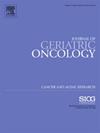Factors associated with the use of immune checkpoint inhibitors in older adults with metastatic non-small cell lung cancer and pre-existing autoimmune disease: A SEER-Medicare study
IF 3
3区 医学
Q3 GERIATRICS & GERONTOLOGY
引用次数: 0
Abstract
Introduction
The presence of pre-existing autoimmune disease (PAD) with metastatic non-small cell lung cancer (mNSCLC) poses challenges in the use of immune checkpoint inhibitors (ICI). This study investigated factors influencing ICI utilization in older adults with mNSCLC and PAD.
Materials and Methods
A retrospective cohort study with a 12-month baseline prior to treatment initiation was conducted using the SEER-Medicare data. Patients aged 66 years and above diagnosed with mNSCLC between January 2015 and December 2017, who initiated immunotherapy only/chemoimmunotherapy (IT/CIT) or chemotherapy only (CIT) and had at least one PAD diagnosed any time before treatment initiation, were included. Multiple factors, guided by the Model of Health Services Utilization, were analyzed using multivariable logistic regression. Adjusted odds ratios (aORs) and 95.0% CIs were reported.
Results
Among 1,319 patients initiating first-line (1L) systemic therapy, 22.3% received IT/CIT and 77.7% received CT. Patients initiating IT/CIT were more likely to be 76–80 years old (aOR = 1.70, 95.0% CI = 1.02–2.81) and > 80 years old (aOR = 2.49, 95.0% CI = 1.46–4.25), reside in South (aOR = 2.32, 95.0% CI = 1.36–3.96) and West (aOR = 2.27, 95.0% CI = 1.44–3.60) SEER regions, diagnosed in 2016 (aOR = 6.36, 95.0% CI = 3.06–13.22) and 2017 (aOR = 40.45, 95.0% CI = 19.70–83.07), having a longer time to treatment initiation (aOR = 1.14, 95.0% CI = 1.08–1.19), having non-squamous tumor histology (aOR = 1.511, 95.0% CI = 1.048–2.179), and having a prior hospitalization (aOR = 1.63, 95.0% CI = 1.14–2.33). These patients were less likely to have recently used an immunosuppressant (IS) (aOR = 0.06, 95.0% CI = 0.04–0.10).
Discussion
Several factors, such as age, region, cancer diagnosis year, time to treatment initiation, and recent IS use, intricately shape treatment decisions. Further in-depth research on each of these factors is imperative to optimize strategies for this distinctive patient population.
患有转移性非小细胞肺癌和原有自身免疫性疾病的老年人使用免疫检查点抑制剂的相关因素:SEER-Medicare 研究。
简介:转移性非小细胞肺癌(mNSCLC)合并自身免疫性疾病(PAD)给免疫检查点抑制剂(ICI)的使用带来了挑战。本研究调查了影响患有mNSCLC和PAD的老年人使用ICI的因素:利用 SEER-Medicare 数据开展了一项以开始治疗前 12 个月为基线的回顾性队列研究。研究纳入了在 2015 年 1 月至 2017 年 12 月期间确诊为 mNSCLC 的 66 岁及以上患者,这些患者仅接受了免疫治疗/化学免疫治疗(IT/CIT)或仅接受了化学治疗(CIT),并且在开始治疗前的任何时间至少确诊了一次 PAD。在医疗服务利用模型的指导下,采用多变量逻辑回归分析了多种因素。报告了调整后的几率比(aORs)和 95.0% CIs:在 1319 名开始接受一线(1L)系统治疗的患者中,22.3% 接受了 IT/CIT,77.7% 接受了 CT。开始 IT/CIT 治疗的患者更有可能是 76-80 岁(aOR = 1.70,95.0% CI = 1.02-2.81)和大于 80 岁(aOR = 2.49,95.0% CI = 1.46-4.25),居住在南部(aOR = 2.32,95.0% CI = 1.36-3.96)和西部(aOR = 2.27,95.0% CI = 1.44-3.60)SEER 地区,在 2016 年确诊(aOR = 6.36,95.0%CI=3.06-13.22)和2017年(aOR=40.45,95.0%CI=19.70-83.07)确诊,开始治疗的时间较长(aOR=1.14,95.0%CI=1.08-1.19),肿瘤组织学为非鳞癌(aOR=1.511,95.0%CI=1.048-2.179),之前住院治疗过(aOR=1.63,95.0%CI=1.14-2.33)。这些患者最近使用免疫抑制剂(IS)的可能性较小(aOR = 0.06,95.0% CI = 0.04-0.10):讨论:年龄、地区、癌症诊断年份、开始治疗的时间以及近期使用过免疫抑制剂等因素对治疗决策的影响错综复杂。必须对这些因素逐一进行深入研究,以优化针对这一特殊患者群体的治疗策略。
本文章由计算机程序翻译,如有差异,请以英文原文为准。
求助全文
约1分钟内获得全文
求助全文
来源期刊

Journal of geriatric oncology
ONCOLOGY-GERIATRICS & GERONTOLOGY
CiteScore
5.30
自引率
10.00%
发文量
379
审稿时长
80 days
期刊介绍:
The Journal of Geriatric Oncology is an international, multidisciplinary journal which is focused on advancing research in the treatment and survivorship issues of older adults with cancer, as well as literature relevant to education and policy development in geriatric oncology.
The journal welcomes the submission of manuscripts in the following categories:
• Original research articles
• Review articles
• Clinical trials
• Education and training articles
• Short communications
• Perspectives
• Meeting reports
• Letters to the Editor.
 求助内容:
求助内容: 应助结果提醒方式:
应助结果提醒方式:


